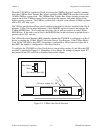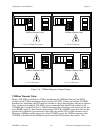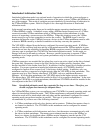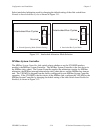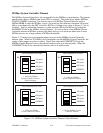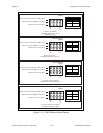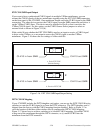Chapter 3 Configuration and Installation
© National Instruments Corporation 3-13 VXI-MXI User Manual
Interlocked Arbitration Mode
Interlocked arbitration mode is an optional mode of operation in which the system performs as
one large VXIbus mainframe with only one master of the entire system (VXIbus and MXIbus) at
any given moment. This mode of operation prevents deadlocks by interlocking all arbitration in
the VXIbus/MXIbus system. Refer to Chapter 6 for a thorough discussion of interlocked
arbitration mode.
In the normal operating mode, there can be multiple masters operating simultaneously in the
VXIbus/MXIbus system. A deadlock occurs when a MXIbus master requests use of a VXIbus
resource in another VXIbus mainframe while a VXIbus master in that mainframe is in the
process of requesting a resource across the MXIbus. When this situation occurs, the VXIbus
master must give up its bus ownership to resolve the conflict. The BERR signal is used to
terminate the transfer on the VMEbus; however, devices in the VXIbus mainframe must be able
to detect a BERR caused by a deadlock condition so that they can retry the operation.
The VXI-MXI is shipped from the factory configured for normal operating mode. If MXIbus
transfers will be occurring both into and out of the mainframe and the VXIbus modules in your
system do not have the capability for handling BERR exceptions caused by deadlock conditions,
you may want to configure the VXI-MXI for interlocked arbitration mode. In this mode, no
changes will need to be made to software. However, parallel processing in separate VXIbus
mainframes is no longer possible, and system performance may be lower than in normal
operating mode.
VMEbus requesters are awarded the bus when they receive an active signal on the daisy-chained
bus grant line. Requesters closest to the Slot 0 device have higher priority, therefore, than
devices installed in slots farther from Slot 0. In addition, four bus request levels further prioritize
modules. For proper operation in interlocked arbitration mode, all VXI-MXIs should be
configured to request at bus request level 3, the factory default setting. In addition, only one
mainframe can have a requester at a higher priority than the VXI-MXIs in that mainframe. This
requester may be a Slot 0 device other than a VXI-MXI, such as a multiframe Resource
Manager. In all the other mainframes, the VXI-MXIs must be the highest priority requesters.
This means that a VXI-MXI should be installed in Slot 0 of its respective mainframe. In the case
of multiple VXI-MXIs in a single mainframe, the additional VXI-MXIs should be installed in the
slots adjacent to the Slot 0 VXI-MXI.
Note: Interlocked arbitration mode has a potential for long access times. Therefore, you
should configure bus timeouts for adequate times.
In a VXIbus/MXIbus system, you can configure some VXI-MXIs for normal operating mode and
others for interlocked arbitration mode. The VXIbus mainframes configured in interlocked
arbitration mode will be interlocked with each other and the mainframes configured for normal
operating mode can perform transfers in parallel. This type of system configuration is
recommended if you have one of the following situations:
• A VXIbus mainframe with only slave devices and no masters. Without bus masters, there is
no chance for deadlock. The VXI-MXIs in this mainframe can be configured for normal
operating mode.
• A VXIbus mainframe with both masters and slaves, but the masters communicate only with
the slaves in their mainframe. The masters never attempt transfers across the MXIbus so
there is no chance for deadlock when a MXIbus master attempts a transfer into the VXI
mainframe. The VXI-MXIs in this mainframe can be configured for normal operating mode.



